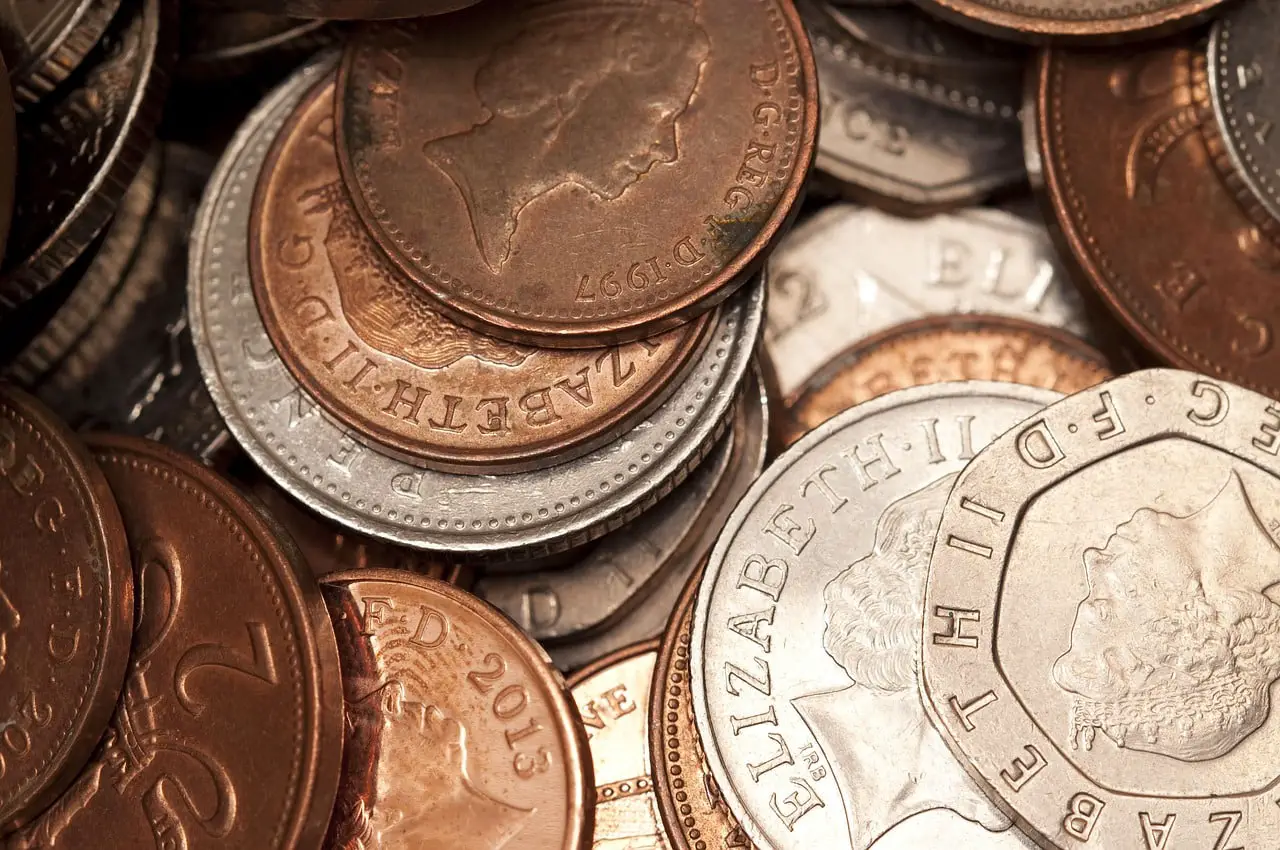UK coins are fascinating in many ways, from the commemorative designs to error versions, but what are Uk coins made from?
The majority of UK coins are produced using cupro-nickel, which is an alloy of copper containing 75% copper and 25% nickel, but this does vary depending on the denomination. For example, 1p and 2p coins are now produced in copper-plated steel. but they were previously issued in bronze.
In the rest of this blog post, we’ll explore every coin in UK circulation to see what they’re made of now and if the composition has changed at all throughout the years.
Let’s get into it.
What Are 1p And 2p Coins Made Of?
When they were initially minted, the 1 penny and 2 pence coins were minted in bronze with a composition of 97% copper, 2.5% zinc, and 0.5% tin.
This composition was used from 1971 until September 1992. Increasing metal prices around the world necessitated the coin’s composition to change. Since 1992, the coins have been minted in steel and electroplated in copper, causing them to become magnetic.
The 1 penny (1p) and 2 pence (2p) coins came into circulation on February 15th, 1971, the day British currency became decimalised. They are the only two denominations made to the same size specifications from their creation to the present day.
What Are 5p And 10p Coins Made Of?
Originally the 5 pence and 10 pence coins were minted from cupro-nickel, comprised of 75% copper and 25% nickel.
This changed in 2012 when it started to be minted in nickel-plated steel due to the rising costs of metal. In January 2013, the previous cupro-nickel coins were removed from circulation and replaced with nickel-plated steel versions, resulting in them being magnetic and also slightly thicker.
The 5 pence (5p) and 10 pence (10p) coins came into circulation on April 23rd, 1968. The 5 pence coin was designed to replace the shilling, and the 10 pence coin was designed to replace the florin, or two shillings, to prepare for decimalisation in 1971.
What Are 20p Coins Made Of?
Since it was introduced, the 20 pence coin has been made from Cupro-Nickel, 75% copper and 25% nickel. The 20 pence coin is considered a legal tender of any amount up to £10. This means it is permissible to have payments refused if you pay a sum greater than this amount to pay a debt.
The 20 pence coin was introduced on June 9th, 1982. It is equal to twenty hundredths, or one-fifth of a pound sterling. The 20 pence is shaped in a seven-sided, equilateral curved heptagon. Since it was introduced, the 20 pence coin has featured the same picture as Queen Elizabeth II as the other coins.
What Are 50p Coins Made Of?
The 50 pence (50p) coin was brought into circulation in 1969. It is equal to one half of a pound. Like the 20 pence, the 50 pence is shaped in a seven-sided, equilateral curved heptagon. Since it was introduced, the 50 pence coin featured the same picture of Queen Elizabeth II as the rest of the coins in rotation.
The 50 pence coin is also similar to the 20 pence coin in that from the time of introduction; the 50 pence coin has been made from Cupro-Nickel, which is 75% copper and 25% nickel.
In 2008 when Matthew Dent redesigned the reverse of the coins, the 50 pence was changed to show the lowest point of the Royal Shield with the words “FIFTY PENCE” below the shield’s point.
Like the 20 pence, the 50 pence coin is considered a legal tender of up to £10. Meaning it is permissible, by law, to have payments refused if you pay a sum greater than this amount to pay a debt.
What Are £1 Coins Made Of?
The original round £1 coin replaced the Bank of England £1 note when it ceased to be issued at the end of 1984. A new twelve-sided, dodecagonal, bimetallic design of the coin was brought into rotation on March 28th, 2017, with the old design being removed from circulation on October 15th, 2017.
The original circular £1 coin was composed of Nickel-Brass, 70% copper, 5.5% Nickel, and 24.5% Zinc. The new bi-metallic coins feature an outer ring composition of 76% copper, 20% Zinc, and 4% Nickel. The inner ring is made of Nickel-plated alloy.
Like the rest of the UK’s coins, the obverse of the £1 has always featured images of Queen Elizabeth II. Unlike the rest of the coins, the reverse of the £1 coin was changed each year from 1983 until 2008. In turn, an emblem represents the UK, Scotland, Wales, Northern Ireland, and England, along with the appropriate edge inscription.
What Are £2 Coins Made Of?
In 1998, the first bi-metallic £2 coins were introduced into circulation with the date 1997. These new £2 coins, which are seen frequently in circulation today, are made from cupro-nickel in the centre and nickel-brass on the outer ring.
Before 1997, there was a series of £2 coins issued which were entirely golden in appearance. These coins were issued as commemorative pieces and were made from just nickel-brass.
Where Are Coins Made In The UK?
Circulating coins in the UK are produced at the Royal Mint, which has its headquarters in Llantrisant, Glamorgan, Wales.
The Mint was originally based in London before it moved to Wales during decimalisation where it has remained.
